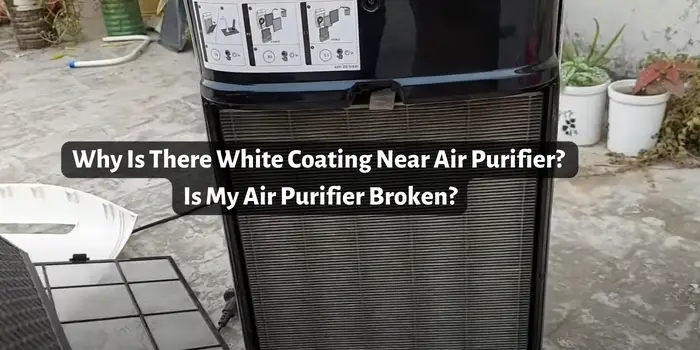Last Updated on August 24, 2025
You might have noticed something curious if you have recently started using an air purifier. A white coating might be near the air purifier or on the floor next to the device. Seeing that, you might have asked yourself why is there white coating near air purifier.
Water-based air purifiers can create a white coating if you fill them up with hard water. However, it is not the device that is creating the coating. Instead, the internal filtration unit cannot filter out the white powder from the humidifier or the HVAC system.
But is that all to the topic, or is there more? To know that, you will need to stick with us till the end of this discussion.
Why Is White Powder Coming Out of the Vents of the Air Purifier?
If you are using a new HVAC system, the white dust might be remnants of film or oil. In these systems, there is a humidifier, which can make the white dust come out. And if the humidifier is making the powder come out of the vents, there is a high chance that the area you are in has a hard water issue.
Now, what exactly is hard water? Water with a high level of minerals falls in the hard water category. And if you are getting white dust out of the air purifier, the water you are using might have a significantly high level of magnesium and calcium. Both of these are silvery to white.
Other than that, you might be living near the coast. In that case, the air will have a high salt content, which you can blame for leaving a white coating near the air purifier. Also, consider that the chalky white powder from the air purifier vents might indicate a carbon monoxide leak.
How to Get Rid of the White Dust Coating Problem of Air Purifiers?
First of all, as we have mentioned, the white dust issue has nothing to do with the air purifier. Instead, the water that you are using is the culprit. So, to avoid white dust issue, start using soft water in the humidifier, air purifier, and other cooling or heating devices you have in your home.
Now, by soft water, we are referring to the water that is distilled. If the air purifier is leaving white dust, you might be using tap water, which might be hard. Alternatively, you can use demineralized or purified water and check whether the white dust issue is still there or not.
Other than that, you should check whether the device you are using has a special slot for demineralization or not. This cartridge will basically trap the minerals before they get into the air. Use it to solve the white coating issue.
That said, if you can not source soft water or the device does not have a demineralization slot, consider switching to a different air purifier. For the next purchase, opt for something that is not electrostatic or water-based. The activated air purifiers, ionizers, and HEPA air purifiers can not create white dust.
Is the White Dust Harmful?
According to EPA, no adverse effects are associated with the white dust that air purifiers and humidifiers leave. However, there is a case where a child got a lung injury after accidentally inhaling the mineral dust produced by the humidifier.
So, if your air purifier or humidifier is releasing this white dust, it would be better not to turn the device on when a child is around.
On that note, if your humidifier air purifier is dirty, you should be concerned about the mold spores and bacteria it releases instead of the white dust. These bacteria and mold spores can cause serious health issues. For that reason, you should clean the device regularly and try to use distilled water for the device.
Which Humidifier Air Purifiers Does Not Create the White Coating?
If you are facing the white dust issue, there is a high chance that you are using an electrostatic air purifier or a water-based one. These are more likely to produce a white film. On the other hand, air purifiers that utilize HEPA filters activated carbon filters, and ionizers will not create this white coating.
However, you need to consider that electrostatic air purifiers are more economically-friendly. Unlike the HEPA filter air purifiers, you can wash the electrostatic filter. That means you might not even have to purchase a replacement during the device’s entire lifespan.
In comparison, for some of the devices, you will need to replace the HEPA filter after every six months. And if the air quality is not usually great in your area, you might even need to get three to four replacements in one year.
Furthermore, electrostatic air purifiers are good at handling allergens. They will be highly efficient in capturing the most common allergens, including pet dander, dust, mold spores, and others. Although the efficiency level will not match the HEPA filter, it still can eliminate 90 percent of airborne allergens.
Final Words
So, in short, the answer to the question of why is there white coating near air purifier would be the water you are using for your water-based air purifier. You might be using tap water, which might be hard. And to solve this, you should switch to using soft water.
